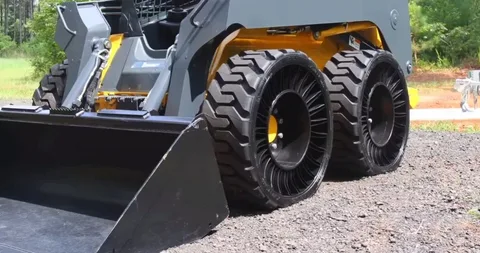Introduction
The Automotive Airless Radial Tire Market is growing rapidly as vehicle manufacturers and consumers increasingly seek durable, maintenance-free, and sustainable tire solutions. Airless radial tires, also known as non-pneumatic tires (NPTs), eliminate the need for air pressure, thereby reducing the risk of punctures, blowouts, and pressure maintenance issues. These tires use innovative materials and structural engineering to provide consistent performance, longer lifespan, and improved safety. They are being adopted in passenger cars, electric vehicles (EVs), commercial fleets, and off-road vehicles due to their reliability and environmental benefits. With the rise of EVs, autonomous vehicles, and fleet-based mobility services, airless radial tires are gaining momentum as a next-generation tire technology designed to enhance efficiency and reduce lifecycle costs.
Market Drivers
The primary driver of the Automotive Airless Radial Tire Market is the rising demand for maintenance-free and durable tire solutions. Traditional pneumatic tires require regular pressure checks and replacements, while airless designs eliminate these challenges entirely. The increase in electric and autonomous vehicles, which prioritize efficiency and reliability, is accelerating adoption. Sustainability initiatives and growing awareness of waste reduction also support market growth, as airless tires have longer service life and are easier to recycle. Manufacturers like Michelin, Bridgestone, and Goodyear are investing heavily in R&D to develop commercial-ready airless tires with superior load capacity and comfort. Additionally, rising safety standards and consumer preference for low-maintenance solutions are pushing automakers to integrate airless tires in next-generation models. The industrial and military sectors also drive demand due to the tires’ resilience in harsh environments.
Market Challenges
Despite their advantages, airless radial tires face challenges related to cost, performance, and scalability. Production of airless tires involves advanced materials and complex manufacturing processes, resulting in higher prices than conventional tires. Heat dissipation remains a technical challenge during high-speed operations, as airless designs must prevent overheating and maintain structural integrity. Ride comfort and noise levels can be slightly lower than pneumatic alternatives, impacting consumer acceptance in the passenger vehicle segment. Widespread commercialization is still limited, with most applications currently in testing or niche markets such as military and off-road vehicles. Additionally, retrofitting airless tires on existing vehicles requires compatibility adjustments, which may limit early adoption. The lack of standardized regulations for testing and certification of airless tire performance further complicates mass deployment.
Market Opportunities
The transition toward electric and autonomous vehicles presents major opportunities for the Automotive Airless Radial Tire Market. EVs benefit greatly from airless designs due to reduced maintenance, enhanced durability, and improved efficiency. The integration of smart sensors for temperature, load, and tread monitoring within airless tires enables real-time diagnostics and predictive maintenance. The development of 3D-printed tire components offers customization and sustainable manufacturing options. Partnerships between tire manufacturers and automakers are accelerating the commercialization of airless tires for passenger cars and fleet vehicles. Emerging markets in Asia-Pacific and Latin America offer growth potential as governments promote road safety and sustainable mobility. The use of eco-friendly, recyclable materials in airless tire production aligns with global circular economy goals. Furthermore, the growing popularity of off-road recreation, military vehicles, and agricultural machinery provides steady demand for durable airless solutions.
Regional Insights
North America dominates the Automotive Airless Radial Tire Market, driven by early technological adoption, strong R&D investments, and active collaborations between tire manufacturers and automakers. The U.S. leads with pilot programs for commercial and passenger vehicles utilizing airless technologies. Europe follows closely, supported by sustainability mandates, EV adoption, and leading tire producers in Germany, France, and the UK. Asia-Pacific is witnessing rapid growth, led by China, Japan, and South Korea, where industrial expansion and high EV penetration are fueling innovation. China’s growing focus on cost-effective and durable mobility solutions offers significant potential for airless tire adoption. The Middle East shows emerging demand in off-road and defense applications, while Latin America and Africa are gradually adopting the technology through fleet modernization initiatives and industrial mobility requirements.
Future Outlook
The future of the Automotive Airless Radial Tire Market will be shaped by innovation, digitalization, and sustainability. Advancements in polymer composites, additive manufacturing, and material science will enhance performance and reduce costs. Integration with smart vehicle systems will enable real-time monitoring and automatic calibration for load balance and wear. As regulatory frameworks evolve, large-scale commercialization of airless tires for passenger vehicles will become viable. Autonomous vehicle fleets, which require low-maintenance and highly reliable components, will accelerate demand. Over the next decade, airless radial tires are expected to transition from prototype to mainstream, revolutionizing the tire industry by offering unparalleled durability, safety, and environmental benefits.
Conclusion
The Automotive Airless Radial Tire Market is growing as innovation, sustainability, and mobility trends converge. While challenges in cost and performance persist, technological advancements and strong OEM partnerships are paving the way for widespread adoption. Airless tires offer a promising alternative to traditional pneumatic models by combining longevity, safety, and environmental efficiency. Manufacturers focusing on scalability, smart integration, and eco-friendly materials will lead market transformation. As the automotive industry embraces electrification and automation, airless radial tires will play a pivotal role in shaping the future of sustainable and intelligent mobility.
